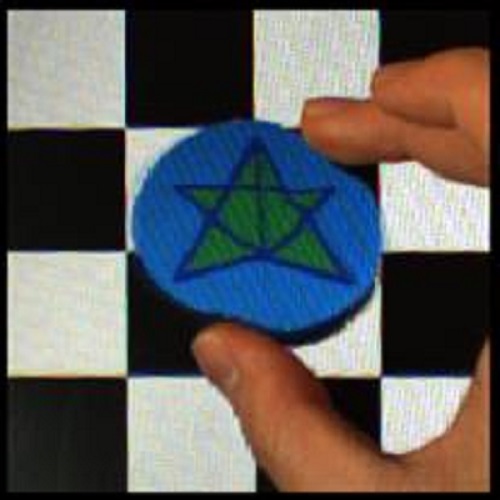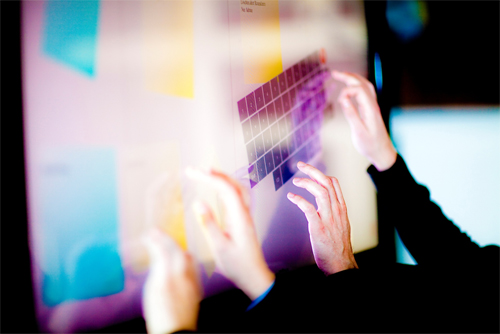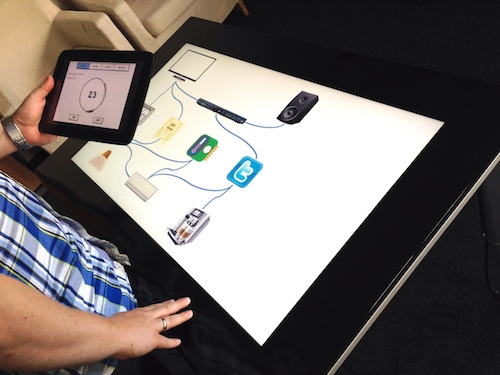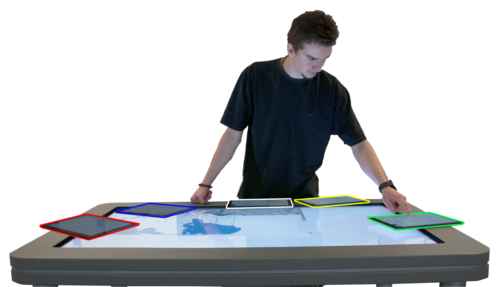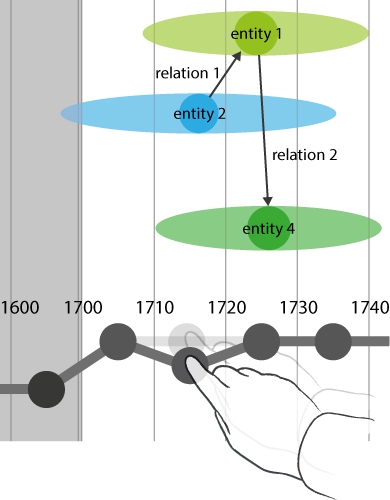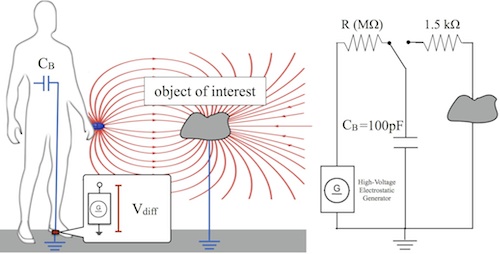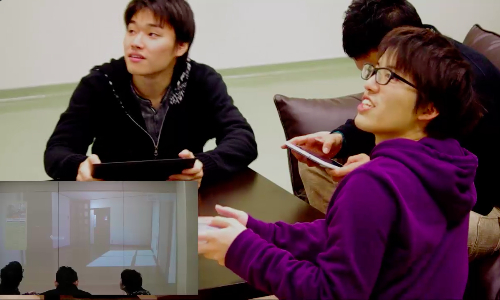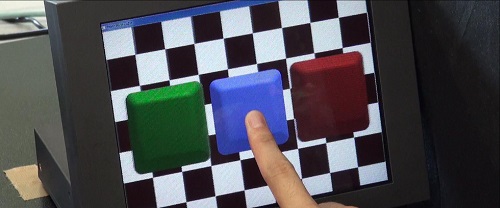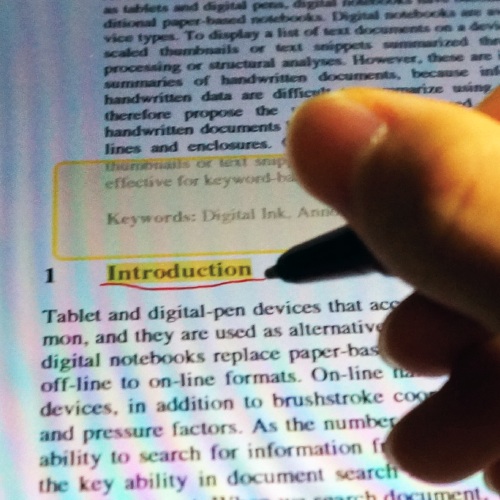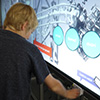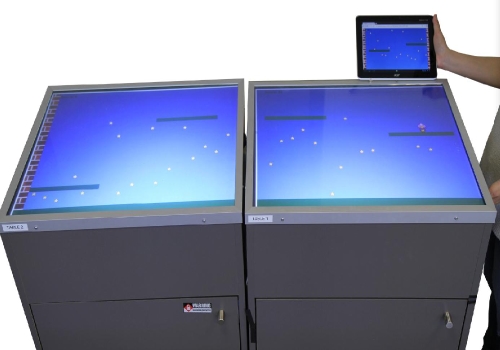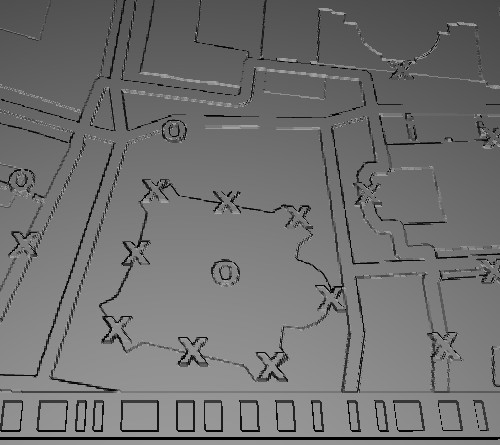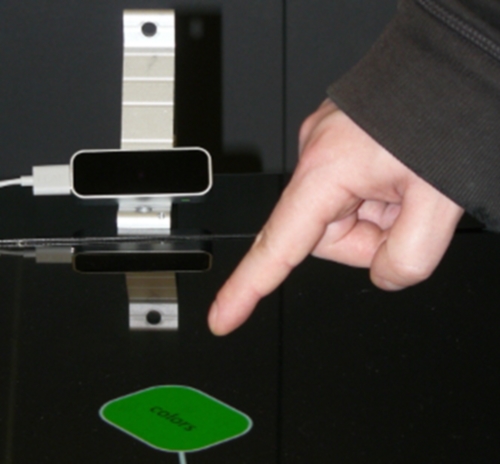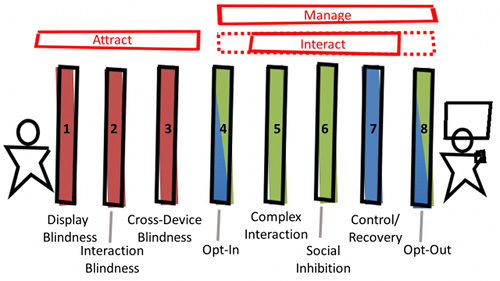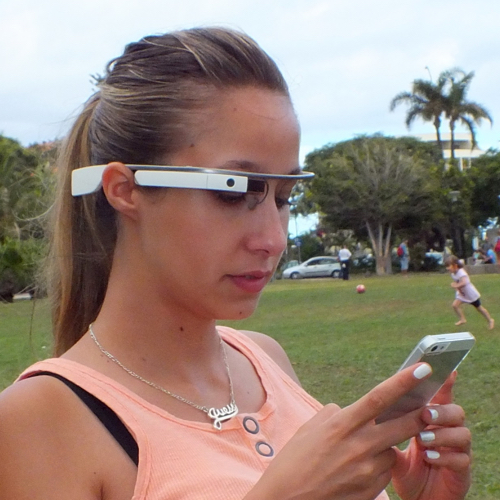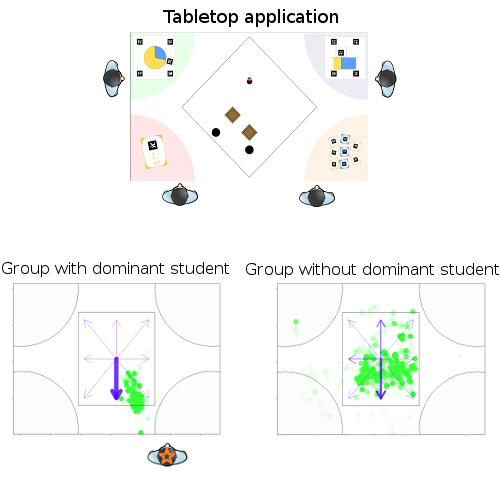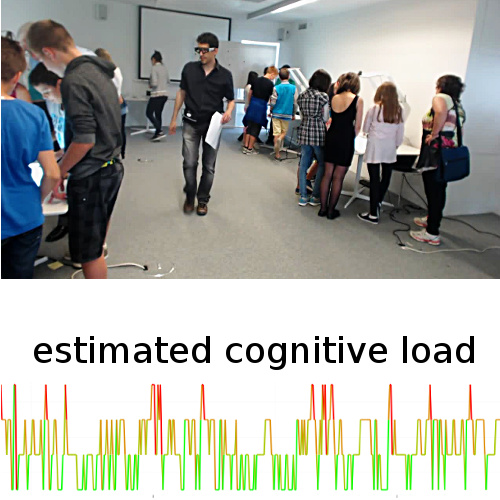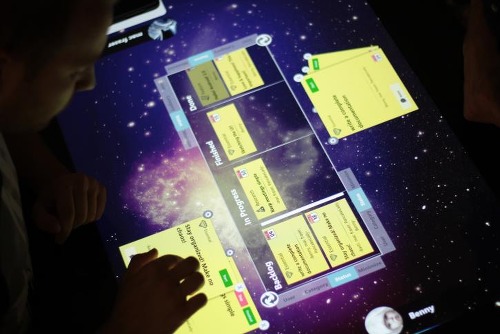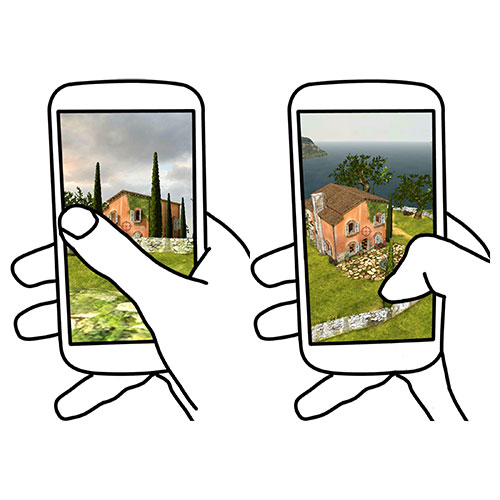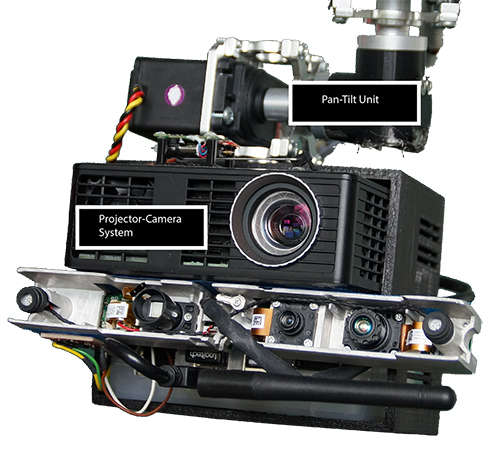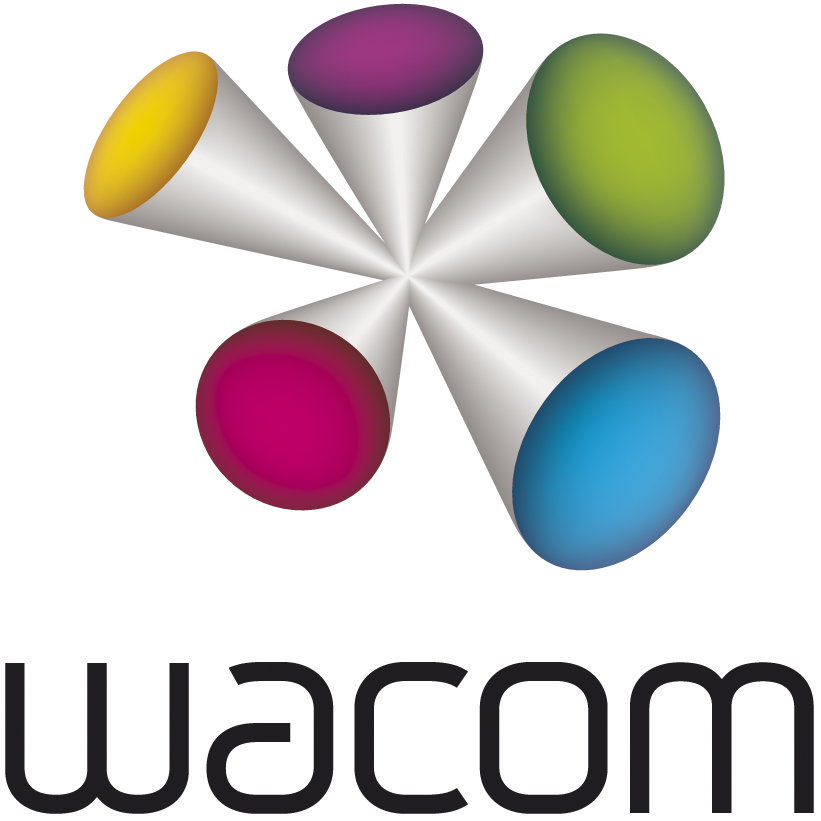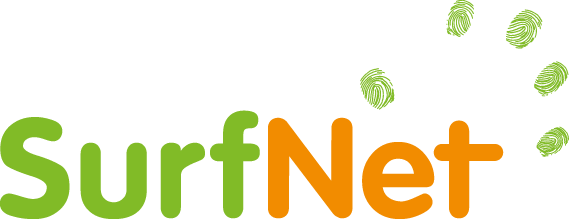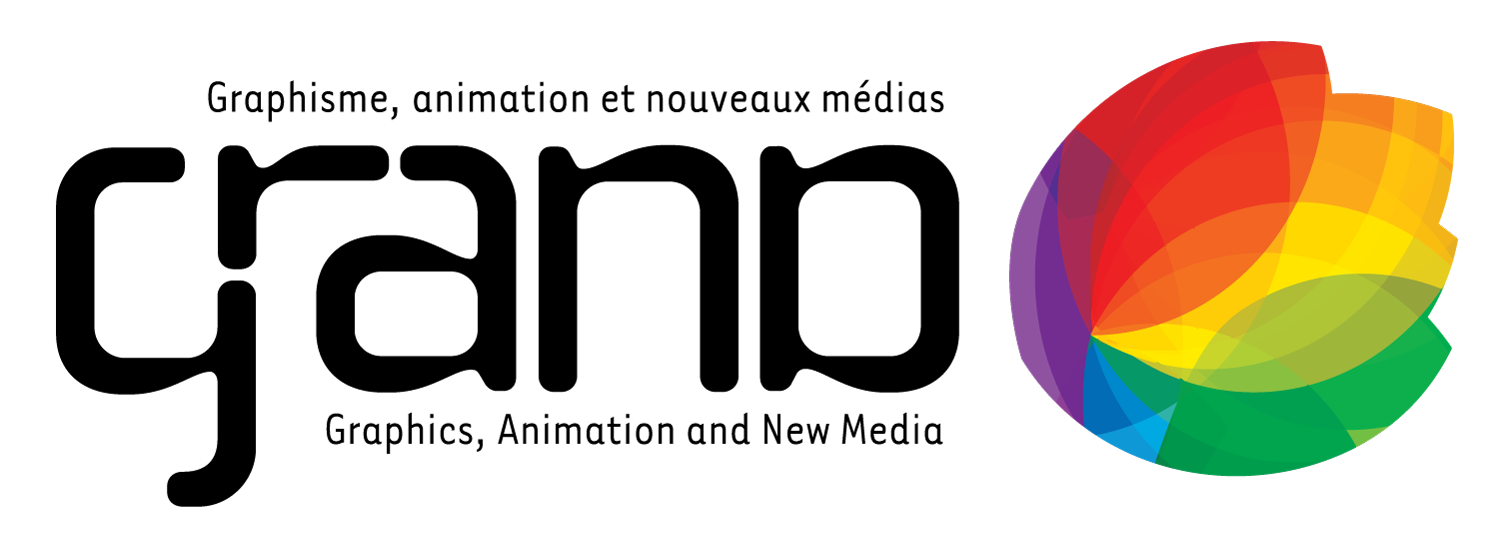Posters
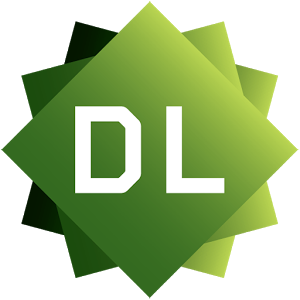
...Click this button to get free pdf access until Nov 2015 provided by ACM OpenTOC service.
3D Tabletop User Interface Using Virtual Elastic Objects 
Hiroaki Tateyama, Takumi Kusano, Takashi Komuro
We propose a method to reduce the inconsistency between virtual and real spaces in manipulating 3D virtual objects with users’ fingers. By elasticizing a virtual object, our system prevents users’ fingers from thrusting into the virtual object and enables 3D interaction with a greater sense of reality.
A Cooperative Multitouch Scrum Task Board for Synchronous Face-to-Face Collaboration 
Jessica Rubart
A Multitouch Scrum Task Board is presented, which is designed for being used by a team synchronously during face-to-face collaboration. Tasks can be created, explored, sorted, resized, and visually arranged in parallel simultaneously by multiple users on a multitouch display. We present our first experiences using the cooperative Scrum Task Board on a multitouch table.
A Multi-Display System for Deploying and Controlling Home Automation 
Yucheng Jin, Chi Tai Dang, Christian Prehofer, Elisabeth Andre
This paper introduces a concept of using a home devices mashup tool to wire home devices on a tabletop display in combination with web based UIs on mobile devices to control home devices. This multi-display system supports multiple people to deploy home networked devices co-located collaboratively and control home devices universally with high accessibility and mobility.
Bancada: Using Mobile Zoomable Lenses for Geospatial Exploration 
Francisco Marinho Rodrigues, Teddy Seyed, Frank Maurer, Sheelagh Carpendale
Bancada is a system developed for the exploration of geospatial information in multi-display environments. Users interact with tablets (Zoomable Magic Lenses) to augment an overview map displayed on a tabletop. Bancada is currently being used to research user interfaces separated across multiple devices and interactions with high-resolution mobile devices.
Combining Timeline and Graph Visualization 
Robert Morawa, Tom Horak, Ulrike Kister, Annett Mitschick, Raimund Dachselt
Node-link diagrams are the predominant visualization for relations in data. However, nodes' temporal properties are difficult to visualize. Combining timeline and graph visualization, we introduce Time Shadows and Time Beads. Time Shadows provide temporal context for nodes. Time Beads present a new form of timeline supporting continuous and discrete navigation, and multiple focus regions.
Corona: Haptic Sensation Using Body-Carried Electrostatic Charge for Body Area Network Feedback Companion 
Adiyan Mujibiya
Corona is a wearable haptic feedback device that uses electrostatic force to provide physical stimuli when a user touches objects that are electrically grounded, or of opposite polarity. Unlike previous approach, we neither physically actuate objects nor use any hand-worn tactile feedback devices. We introduce a mechanism to artificially build up electrostatic charge within the human body.
Cyber Chamber: Multi-user Collaborative Assistance System for Online Shopping 
Masafumi Muta, Kenji Mukai, Ryoutarou Toumoto, Motoi Okuzono, Junichi Hoshino, Hiromi Hirano, Soh Masuko
Evaluation of Visuo-haptic Feedback in a 3D Touch Panel Interface 
Xu Zhao, Takehiro Niikura, Takashi Komuro
Exploring Multi-Surface Interactions in Retail Environments 
Sydney Pratte, Teddy Seyed, Frank Maurer
Intelligent Ink Annotation Framework that uses User's Intention in Electronic Document Annotation 
Hiroki Asai, Hayato Yamana
We propose the Intelligent Ink Annotation Framework that helps the system to increase learnability of annotation systems by detecting recognizable intentions from natural annotation behavior on paper-based documents. Our framework recognizes "Targeting Content" and "Commenting", which are related to extraction of annotation information.
Interact! An Evidence-Based Framework For Digitally Supported School Field Trips 
Alexandra Tanner, Beat Vollenwyder, Michael Kalt, Ulrike Schock, Magdalena Mateescu, Doris Agotai, Peter Gros, Manfred Vogel, Carmen G. Zahn
Interact! is an evidence-based framework for the support of school class visits to science exhibitions featuring a large vertical multi-touch surface and a set of tablet computers. The framework is designed to foster interest in computer sciences and collaborative learning by drawing upon subject areas of personal importance and encouraging small group knowledge processes
Interactive Surface Composition Based on Arduino in Multi-Display Environments 
Lili Tong, Audrey Serna, Sébastien George, Aurélien Tabard, Gilles Brochet
We presented a new infrastructure that allows dynamic reconfiguration of the interactive space by grouping different devices together. The architecture is based on a Web server and websockets that enables rapid pairing of devices, and simple magnetic switches to provide location awareness of devices relative to each others.
Interactive Tactile Maps for Blind People using Smartphones’ Integrated Cameras 
Timo Götzelmann
This approach integrates barcodes into tactile maps to allow their detection by standard smartphones' cameras. A mobile application automatically obtains more detailed map data to auditively support the user's exploration of the tactile map. An experimental implementation shows the principal feasibility and provides the basis for comprehensive user studies.
Making Tabletop Interaction Accessible for Blind Users 
Andreas Kunz, Dirk Schnelle-Walka, Ali Alavi, Stephan Pölzer, Max Mühlhäuser, Klaus Miesenberger
Overcoming Interaction Barriers in Large Public Displays Using Personal Devices 
Victor Cheung, Diane Watson, Jo Vermeulen, Mark Hancock, Stacey Scott
This work presents a design space in which personal devices are used as a means to facilitate “socially safe”, ad-hoc interaction with large public displays. We identify barriers hindering this process, and focus on minimizing the effort required to initiate, sustain, and withdraw from interaction with a large public display.
Second Look: Combining Interactive Surfaces with Wearable Computing to support Creative Writing 
Pedro Campos, Frederica Gonçalves, Michael Martins, Miguel Campos, Paulo Freitas
We present “Second Look”, a platform of interactive surfaces and wearable computing for helping people, in particular creative writers, to overcome writer’s block. The novelty of our systems stems from the addition of wearable devices (Google Glass) and crowdsourcing to improve creative writing on tablets and phones.
Single Locus of Control in a Tangible Paper-based Tabletop Application: An Exploratory Study 
Daniela Caballero, Yun Wen, Luis P Prieto, Pierre Dillenbourg
We describe the design of a novel tangible, paper-based tabletop application for learning about fractions collaboratively. We also describe in detail how we designed its interface with a single element of control (locus of control) to foster equal participation, and how the analysis of its position and rotation can provide insights on the collaboration processes of students.
Studying Teacher Cognitive Load in Multi-tabletop Classrooms Using Mobile Eye-tracking 
Luis P Prieto, Yun Wen, Daniela Caballero, Kshitij Sharma, Pierre Dillenbourg
In this initial study, we used a mobile eye-tracker to follow the facilitator's cognitive load in several simulated lessons with real school children, conducted in a multi-tabletop environment. The video coding of high- and low-load episodes provided insights on what aspects of managing such multi-tabletop setting can be more challenging for a teacher (e.g., class-wide awareness).
Task Assignment and Visualization on Tabletops and Smartphones 
Benedikt Haas, Florian Echtler
ThumbCam: Returning to single touch interactions to explore 3D virtual environments 
Daniel Mendes, Maurício Sousa, Alfredo Ferreira, Joaquim Jorge
Most solutions to navigate 3D virtual environments using small handheld devices rely on multi-touch, which is not always feasible. ThumbCam is a novel single-touch technique for camera manipulation, which allows users to move and look around using only the thumb, offering more operations with a single touch than existing techniques.
UbiBeam: An Interactive Projector-Camera System for Domestic Deployment 
Jan Gugenheimer, Pascal Knierim, Julian Seifert, Enrico Rukzio
We conducted an in-situ user study by visiting 22 households and exploring specific use cases and ideas of portable projector-camera systems in a domestic environment. Using a grounded theory approach, we identified several categories such as interaction techniques, presentation space, placement and use cases. Based on our observations, we designed and implement UbiBeam, a domestically deployable projector-camera system.
Using Scalable, Interactive Floor Projection for Production Planning Scenario 
Michael Otto, Michael Prieur, Enrico Rukzio
A novel system for interactive evaluation and verification of manual assembly processes will be presented. The approach utilizes a scalable, interactive augmented floor surface in combination with a tangible tabletop hardware and a material zone planning software. The floor projection hardware is used for true to scale assembly station layout visualizations.
